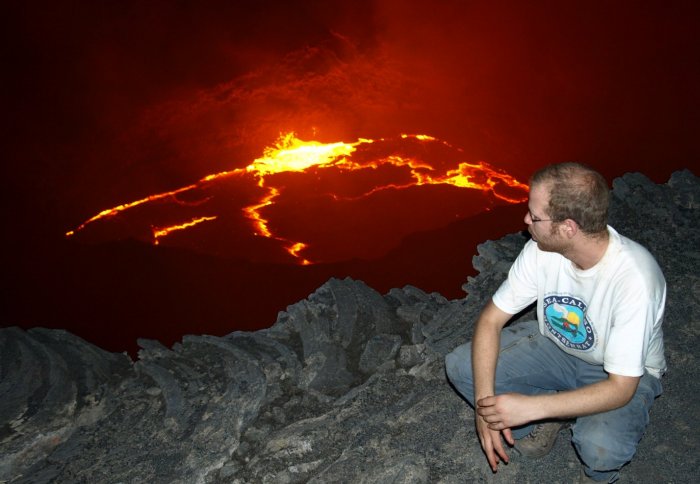

An Imperial researcher discusses what is happening below the Earth's crust in Africa.
A powerful earthquake in China’s rural south-west, which measured 6.6 in magnitude, highlighted the importance of research to understand what is happening inside the Earth’s rocky and often violent interior.
Dr James Hammond, from the Department of Earth Science and Engineering at Imperial, has published research in the journal Geology about what is happening to a region below the Earth’s crust called the mantle. He is studying the mantle in a part of East Africa called the Afar Depression, which is located in Ethiopia, Eritrea and Djibouti. The Natural Environment Research Council Fellow used sound waves to develop images of the environment 400 kilometres underground.
What is happening to the Earth's crust?
The Earth’s crust is divided into different sections called tectonic plates. These massive sheets of rock are continually being pushed around by movements in the mantle, shifting at a glacial pace, millimetre by millimetre, re-shaping the Earth’s surface over millions of years. In some regions such as Asia these plates slowly collide together, pushing upwards to form the Himalayas. This causes large earthquakes such as that seen recently in China. In other places like Africa the plates move apart, breaking up the continent, which is what we look at in our study.

Dr James Hammond at the Erta Ale lava lake in Afar
Why did you look at this section of the Earth's crust under Africa?
In our study we looked at a place called the Afar depression, which is the northern extreme of the East Africa rift. In this region two plates are pulling away from one another. This will eventually cause the eastern part of Africa to split away from the rest creating a new sea in the process, but it will take millions of years to happen. We call this process continental breakup and the Afar depression is the only place in the world on land where we can study the final part of this process, which is really unique.
What might we learn more from studying continental break-up?
Understanding how the Earth has reshaped itself is fundamental in our understanding of how we and the Earth have evolved.
Earthquakes and volcanoes are both common along plate margins, including in East-Africa. Improving our understanding of how continental breakup works will allow us to better understand these hazards.
In East Africa hot material rising from the interior of the Earth is responsible for Africa's unusually high elevation, which is on average 1.5 kilometres above sea level. By better understanding this, we can predict how this uplift of the crust occurred.
Interestingly this process controls how oil is formed in the East Africa's river basins. So, our work is also important for petroleum companies.
Also, this uplift process is an important factor in modeling how sea-levels will change, which impacts on our climate.
How did you study what is going on underground in the region?
We used seismometers deployed across east Africa to record earthquakes from all over the world. Energy from these earthquakes travels through the Earth as sound waves and much like a doctor uses X-rays, we use these sound waves to build up 3D images of the Earth’s structure 400 kilometres below the surface.
Can you paint a picture of what this subterranean world is like?

Molten rock rising to the surface via volcanic vents
The Earth below the Afar Depression is made up of rocky material. In our research, we show that part of this rock is molten. The molten rock is present in small amounts and can work its way through the rock to the surface. Imagine a box with sand in it. If you poured water in to the sand it would slowly work its way down and come out of the bottom of the box. The molten rock in the Earth does a similar thing, but in this case the molten rock is less dense than the surrounding rock and so it travels up along small gaps in the rock to the surface where it eventually erupts at one of the numerous volcanoes in the region.
What does this tell us about what is happening to the region?
In a few million years time this process will cause Africa to split in two, creating an entirely new ocean and a continent. If we use the current geography of Africa, this huge new continent would include all of Somalia and half of Ethiopia, Kenya and Tanzania.
What are the next steps with your research?
Building on this research I am currently extending the seismic network into Sudan and Somalia. I am combining it with data extending from Saudi Arabia to South Africa. Using this information I will be able to image inside the Earth in greater detail than ever before to depths of 1500 kilometres. This will show what drives plate movements in East-Africa and, at a more fundamental level, how heat escapes from the interior of the Earth.
Supporters

Article text (excluding photos or graphics) available under an Attribution-NonCommercial-ShareAlike Creative Commons license.
Photos and graphics subject to third party copyright used with permission or © Imperial College London.
Reporter
Colin Smith
Communications and Public Affairs

Contact details
Email: press.office@imperial.ac.uk
Show all stories by this author



